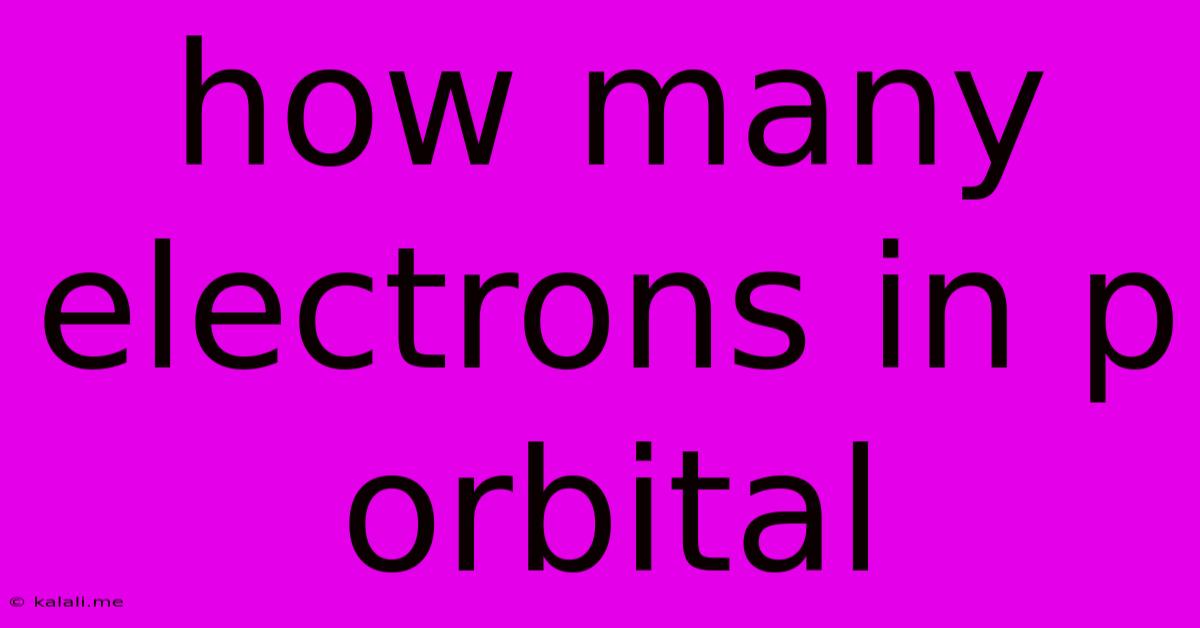How Many Electrons In P Orbital
Kalali
May 21, 2025 · 3 min read

Table of Contents
How Many Electrons Can a p Orbital Hold? A Deep Dive into Atomic Structure
Understanding electron configuration is fundamental to grasping the behavior of atoms and molecules. A key component of this understanding lies in knowing how many electrons can occupy a p orbital. This article will explore that question, delving into the quantum numbers that govern electron placement and explaining the significance of this limit.
The p Orbital: A Quick Overview
Before diving into electron capacity, let's briefly revisit the p orbital. Within an atom, electrons reside in orbitals, regions of space where there's a high probability of finding an electron. The p orbital is one of the types of atomic orbitals, distinguished by its shape and energy level. Unlike the spherical s orbital, the p orbital has a dumbbell shape, with two lobes extending on either side of the nucleus. Each energy level (n) beyond the first (n=1) has a set of three p orbitals, designated as p<sub>x</sub>, p<sub>y</sub>, and p<sub>z</sub>, oriented along the x, y, and z axes respectively. This three-fold degeneracy means they have the same energy level.
Quantum Numbers and Electron Capacity
The maximum number of electrons a p orbital can hold is determined by the Pauli Exclusion Principle and Hund's Rule. These rules govern how electrons fill atomic orbitals.
-
Pauli Exclusion Principle: This principle states that no two electrons in an atom can have the same set of four quantum numbers. These quantum numbers describe the state of an electron:
- Principal Quantum Number (n): Describes the energy level and size of the orbital (n = 1, 2, 3...).
- Azimuthal Quantum Number (l): Describes the shape of the orbital (l = 0 for s, l = 1 for p, l = 2 for d, etc.).
- Magnetic Quantum Number (ml): Describes the orientation of the orbital in space (ml = -l, ..., 0, ..., +l). For p orbitals (l=1), ml can be -1, 0, or +1, corresponding to px, py, and pz orbitals respectively.
- Spin Quantum Number (ms): Describes the intrinsic angular momentum of the electron, which can be either +1/2 (spin up, ↑) or -1/2 (spin down, ↓).
-
Hund's Rule: This rule states that electrons will individually occupy each orbital within a subshell before doubling up in any one orbital. This minimizes electron-electron repulsion.
Because each p orbital (px, py, pz) can hold a maximum of two electrons (one spin up and one spin down), and there are three p orbitals in a subshell, a p subshell can hold a total of six electrons.
Illustrative Example: Nitrogen (N)
Let's consider nitrogen, which has an atomic number of 7, meaning it has 7 electrons. The electron configuration for nitrogen is 1s²2s²2p³. The 1s and 2s orbitals are filled with 4 electrons, leaving 3 electrons to occupy the 2p orbitals. According to Hund's rule, these three electrons will individually occupy the 2p<sub>x</sub>, 2p<sub>y</sub>, and 2p<sub>z</sub> orbitals, each with a spin up electron.
In Summary
Therefore, to answer the question directly: a single p orbital can hold a maximum of two electrons, while a p subshell (containing three p orbitals) can hold a maximum of six electrons. This fundamental concept is crucial for understanding chemical bonding, molecular geometry, and many other aspects of chemistry. Understanding the limitations imposed by quantum mechanics on electron occupancy allows for prediction of the chemical properties of an atom.
Latest Posts
Latest Posts
-
Pit Bull And Bull Terrier Mix
May 22, 2025
-
Can You Put Aerosols In Hold Luggage
May 22, 2025
-
How To Get Oil Off The Wall
May 22, 2025
-
How Deep Should A French Drain Be
May 22, 2025
-
Can I Drink Tap Water In Spain
May 22, 2025
Related Post
Thank you for visiting our website which covers about How Many Electrons In P Orbital . We hope the information provided has been useful to you. Feel free to contact us if you have any questions or need further assistance. See you next time and don't miss to bookmark.